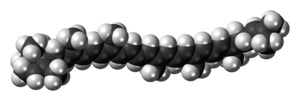Δ-Carotene
Appearance

| |

| |
| Identifiers | |
|---|---|
3D model (JSmol)
|
|
| ChemSpider | |
PubChem CID
|
|
| UNII | |
CompTox Dashboard (EPA)
|
|
| |
| |
| Properties | |
| C40H56 | |
| Molar mass | 536.873 |
Except where otherwise noted, data are given for materials in their standard state (at 25 °C [77 °F], 100 kPa).
| |
δ-Carotene or ε,ψ-carotene is a form of carotene with an ε-ring at one end, and the other uncyclized, labelled ψ (psi). It is an intermediate synthesis product in some photosynthetic plants between lycopene and α-carotene (β,ε-carotene) or ε-carotene (ε,ε-carotene).[1] δ-Carotene is fat soluble.
References
- ^ Cunningham FX, Gantt E (February 2001). "One ring or two? Determination of ring number in carotenoids by lycopene epsilon-cyclases". Proceedings of the National Academy of Sciences of the United States of America. 98 (5): 2905–10. doi:10.1073/pnas.051618398. PMC 30238. PMID 11226339.
